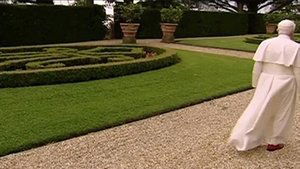
The Sistine Chapel, The Chapel of the Begin and the End. The most tremendous proof of the genius of Michael Angelo and might of vision of the Pope, who entrusted him painting of these - nowadays most famous frescos of the world - Julius II. The episode XIV tells the story about one of the most dramatic rescue action of contemporary world; about unparalleled work of art in the history - conservation of the frescos in the Sistine Chapel.

Formerly, one had to kiss Papal slippers and to talk to the Pope was possible only through the master of ceremony. Nowadays, everyone can shake Papal hands. Popes came down from king's thrones, litters, were emerging from the clouds of incense, in order finally to become someone very close and valued to us. In this episode we are trying to describe the big change that was done in the last hundred years during which the figure of the Holy Father became for million of faithful, as close as their own local person.

The Vatican has its own radio, newspaper and television. What are the Vatican media like? How were they established? What makes a difference between them and laics media? The Church spanned since ages from mass media and at the same time was learning the difficult art of conflict less existence in the world dominated by the media. The episode XII tells the story about Vatican media, their history and difficult relations between the Church and world of laics mass media.

What exactly is taking place underneath the floor-board of exhibition halls of Pinacoteca? The answer is simple: hidden from the tourists eyes, huge, expensive and required of angelic patience, devotion and knowledge conservatory works. The Vatican is the world biggest "hospital" for works of art. Tens of paintings, sculptures, frescos, books and documents are being repaired here on daily basis. About fight for their survival, about work of Vatican conservators of work of arts you will learn from this episode.

Who actually lives in the Vatican? Are any children living there? Can young, laic woman live in the Vatican? Answer - and not only - for these questions you will find in this episode. You will see how exactly do laics live there and who attends a school with boarding house within Vatican. Because Vatican is not only old, celibacy-bound men - it is a small town, quite similar to other towns in the world with the same problems as any others.

The Vatican Gardens. The oldest gardens in the world - we learn about their history and nowadays situation. Walking through the paths of gardens we will see the traces that were left by history of Vatican and the Church. We will also learn the opinions of hierarchs - searching for the rest in here, its workers who on daily basis take care of gardens, as well as gardening sharps who try to find an answer for the question of esthetical quality of the gardens.

The Vatican Museums were developing over the centuries having their dramatic moments. They were private collections turning into real museums after ages. Thir begin was Octagon - one of the "magic places" in the Vatican.Visiting the most important for the history of Museums halls and buildings - we are discovering the mistery of reasons for which the Vatican Museums are one of the most important treasury of cultural inheritance of mankind.

Where does the papamobile come from? What car did Pope use before this worldwide known vehicle was produced? Where from and when did the first car in the Vatican turn up? Why did Popes in the XX Century choose Mercedes? What ever the Papal carriages really used for? How did the Popes travel? This episode narrates about it...

Does Papal milk exist? Yes, of course! And where does it originate? It is explained in this episode, not only this... We are getting to know here the Vatican industry. We are learning about place of print of Vatican publishing offices and postal stamps. We are visiting the Vatican farm in Castel Gandolfo. We are discovering who are the workers taking care of the Basilica for hundreds of years, as well as the history of the oldest service company of the world: The Venerable Factory of St. Peter.

The St. Peter's Basilica is the finest baroque Christian Temple. Three of its most important elements: dome, canopy and tomb of St. Peter, make stome and marble-spelled manifesto of the Christian faith. Metaphoric meaning of them, as well as their history and other treasures of the Basilica - Pieta, Grave of Alexander VII, Obelisk, The Finger of St. Peter - are revealed by the most famous experts in the art and Basilica history.

What is the Swiss Guard existing for? Why do young Swiss males constantly join it's forces? What is the history of this 500-years old military unit? The episode IV tells about the Swiss Guard: its daily life, bloody and dramatical history, reforms undertaken over the centuries, and about it's biggest feast day - recruit oath.

When we enter the St. Peter's Square - we cross the border between Italian Republic and State of Vatican City. What exactly is it? Why and what for was it established? What is its history? How is it functioning and what is its life? And who is its Prime Minister? Alle these questions are included and answered in this episode.

This episode tells the story of discovery of The Apostles Prince's grave and explains why the St. Peter's Basilica was built exactly on the slope of the Vatican hill. We witness the history of the most dramatical archeological surveys in the history of the Church crowned by success, that confirmed authenticity of old Christian tales about the place of burial of St. Peter.